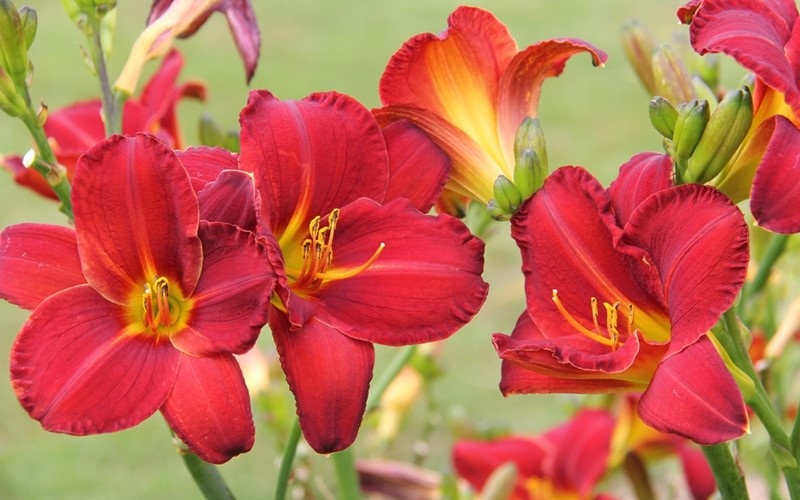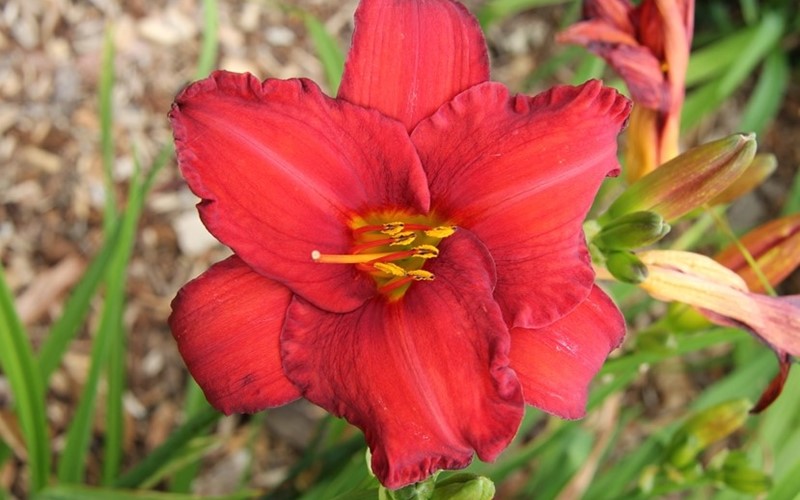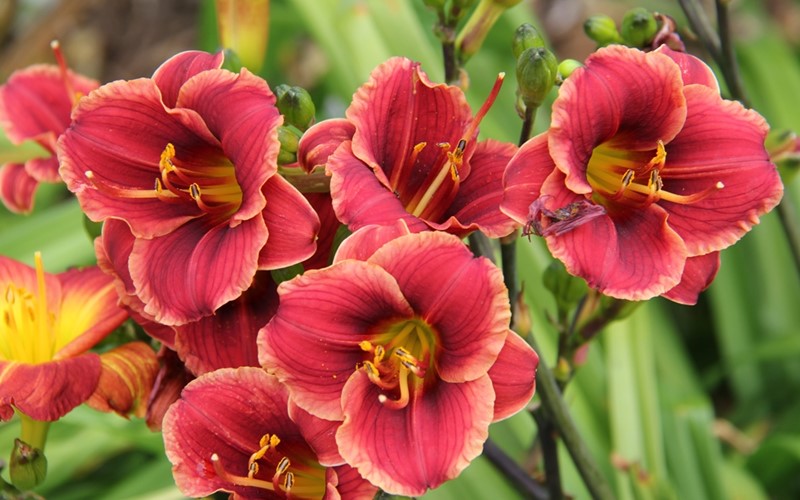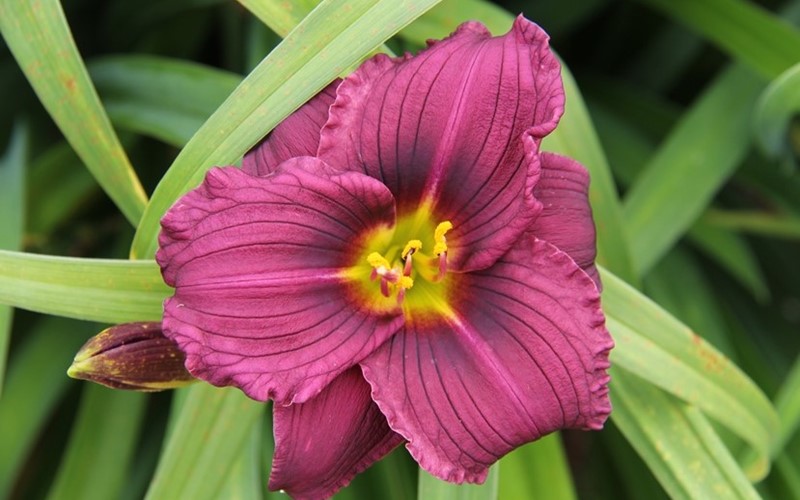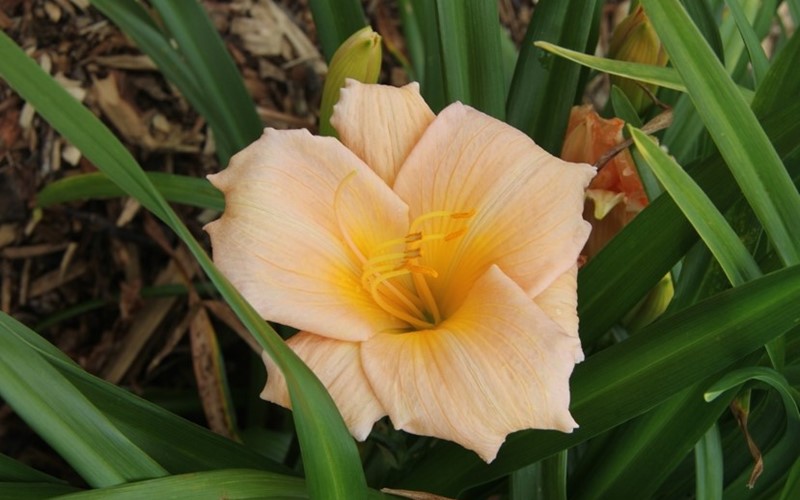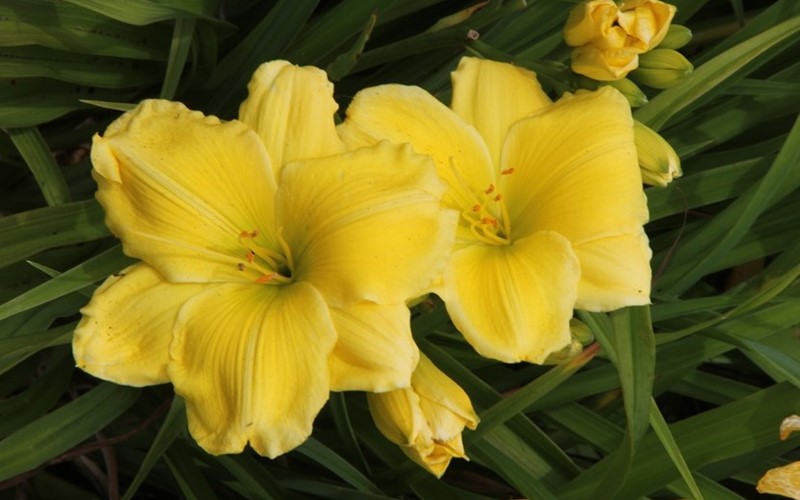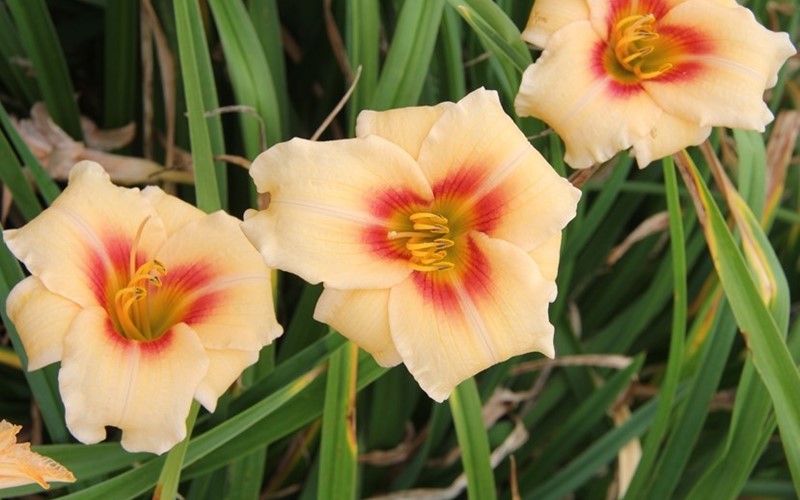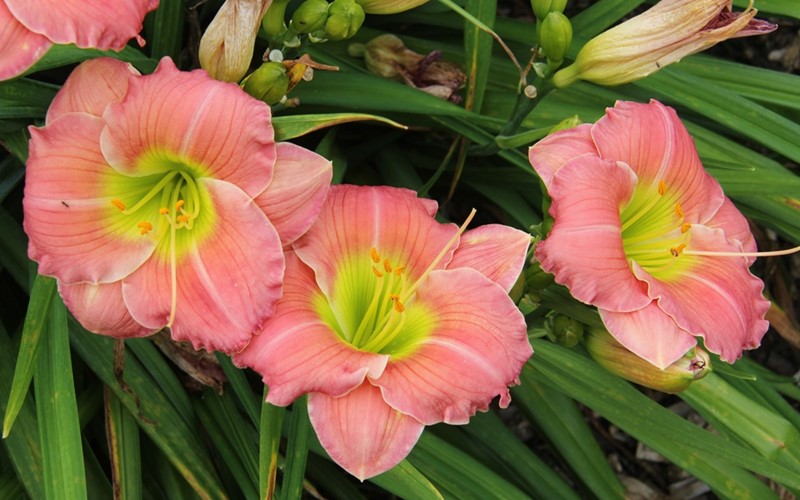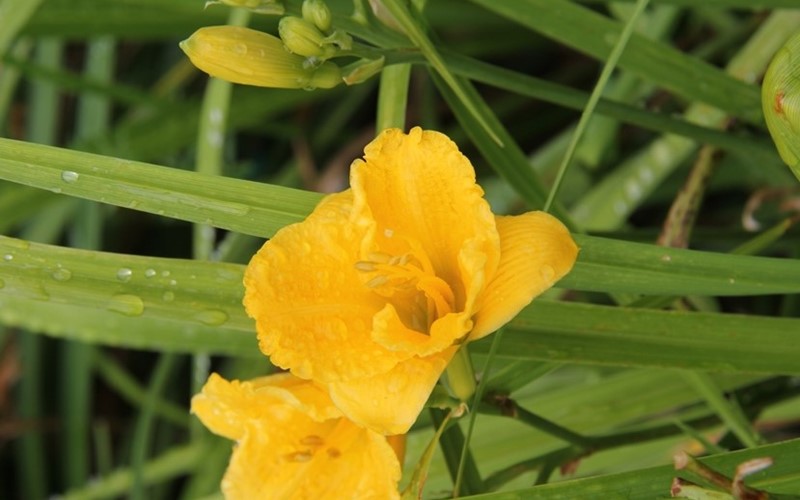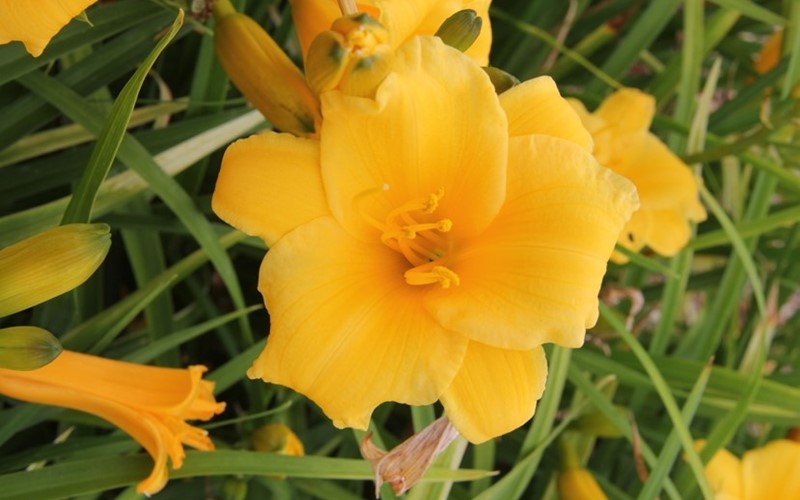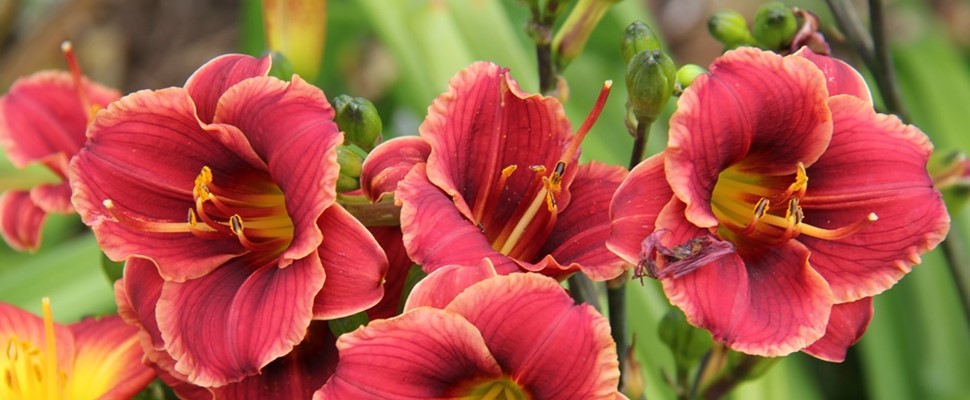
Daylily rust trial
Which one performs well in Auckland?
Introduction
Hemerocallis, or daylilies, are an early to late summer flowering perennial. They are a popular garden plant that used to be considered relatively pest and disease free in New Zealand but now suffers from severe rust. Hemerocallis rust is a relatively new disease to New Zealand which is caused by a fungus, Puccinia hemerocallidis, that spreads rapidly and causes yellow pustules on the underside of the leaves which spreads over the entire leaves (Mueller et al., 2003). Daylily rust is spread through spores and these require relatively warm temperatures and high humidity – which are typical of Auckland conditions.
Puccinia hemerocallidis was first reported in New Zealand, from Auckland, in November 2011 and was collected in the Bay of Plenty in 2013 (PDD fungal collection records). Among other countries, it was recorded in Australia in 2002, the USA in 2000 (by 2002 Hemerocallis rust was found in more than 24 American states) and Brazil in 2001 (Mueller et al., 2003; Smith, 2009; Inokuti et. al., 2012).
We aimed to identify top performing Hemerocallis in Auckland which are rust resistant in order to recommend the best cultivars for Auckland gardens. Results of this trial may be applicable to other regions of New Zealand and will also help inform future breeding programmes by identifying those cultivars that are most rust resistant.
Methods
Three plants of each of 55 cultivars (Table 1) were planted in December 2009 in Auckland Botanic Gardens (ABG) trial beds. Plants were evaluated for five years in the trial then removed in early 2015. Over this time, plants were regularly assessed on their flowering period, flower colour, form/habit, plant vigour, amount of rust present on foliage, and overall performance. Each cultivar was given an overall rating based on both pest and disease observations, including rust and insect damage at ABG. The overall rating (1 = poor performer and 10 = excellent performer) was used to determine the list of top performers. Cultivars that scored 8 or more were considered top performers and would be recommended based on the results of these trials.
Soils in Auckland are mostly clay, therefore the trial beds had compost and mulch applied to improve soil conditions. Fertiliser was applied at the time of planting. Plants were pruned to ground level once a year in autumn. Plants were watered infrequently and only when required in summer.
Results and conclusions
Table 2 shows the list of cultivars that are considered top performers in Auckland conditions, are relatively rust resistant and include both evergreen and deciduous cultivars. It is important to note that depending on local environments some cultivars will vary on their deciduous or evergreen characteristics. All cultivars listed as top performers (Table 2) scored an 8 or higher in our evaluations.
Hemerocallis ‘Chicago Apache’ is rust resistant compared to other cultivars in the trial scoring lower than 8, which agrees with laboratory experiments conducted by Mueller et al. (2003).
Hemerocallis ‘Mini Pearl’ was one of the top performers in the ABG trial; however Mueller et al. (2003) only found it moderately resistant in the laboratory.
We found Hemerocallis ‘Little Grapette’ to be a good performer in Auckland conditions, unlike in the United States where it showed susceptibility to rust (Mueller et al., 2003).
Hemerocallis ‘Cade Stewart’ was also a top performer, however, it should be noted that its old foliage is susceptible to rust and therefore should be removed.
We recommend an
Although we tested 55 commercially available Hemerocallis cultivars, at least 1000 more selections have been cultivated in New Zealand (e.g., Gaddum, 2001), demonstrating the popularity of this plant. Our trials should help ensure that some daylily selections can continue to be grown by gardeners with relative ease.
Table 1
List of all 55 Hemerocallis cultivars in rust trial.
|
H. ‘Baby Betsy’ |
H. ‘Bashful Belle’ |
H. ‘Betty Woods’ |
|
H. ‘Blythe Belle’ |
H. ‘Cade Stewart’ |
H. ‘Cane Fire’ |
|
H. ‘Cherry Smoke’ |
H. ‘Chicago Apache’ |
H. ‘Crimson Icon’ |
|
H. ‘Dancing Dwarf’ |
H. ‘Daring Deception’ |
H. ‘Dark Elf’ |
|
H. ‘Double Cameo’ |
H. ‘Double Cutie’ |
H. ‘Elsie Spalding’ |
|
H. ‘Elves’ Wine’ |
H. ‘In Excess’ |
H. ‘Jeune Rose’ |
|
H. ‘Jeune Tom’ |
H. ‘Kent’s Favourite’ |
H. ‘King Lamoni’ |
|
H. ‘Lady Mischief’ |
H. ‘Little Fat Dazzler’ |
H. ‘Little Favourite’ |
|
H. ‘Little Grapette’ |
H. ‘Little Gypsy Vagabond’ |
H. ‘Little Monica’ |
|
H. ‘Little Mutt’ |
H. ‘Little Showoff’ |
H. ‘Little Topsy’ |
|
H. ‘Little Zinger’ |
H. ‘Littlest Angel’ |
H. ‘Lullaby Baby’ |
|
H. ‘Mellow Yellow’ |
H. ‘Mini Pearl’ |
H. ‘Moon Goddess’ |
|
H. ‘Moonlight Mist’ |
H. ‘Pandora’s Box’ |
H. ‘Pixie Parasol’ |
|
H. ‘Pony Ride’ |
H. ‘Prairie Blue Eyes’ |
H. ‘Rose Cherub’ |
|
H. ‘Rose Emily’ |
H. ‘Seeing Red’ |
H. ‘Sir Galahad’ |
|
H. ‘Slade Brown’ |
H. ‘Sorcerer’s Song’ |
H. ‘Squeaky’ |
|
H. ‘Stella Bella’ |
H. ‘Stella d’ Oro’ |
H. ‘Streaker’ |
|
H. ‘Tiny Pumpkin’ |
H. ‘Velvet Shadows’ |
H. ‘Wild Enchantress’ |
|
H. ‘Wildflower Tango’ |
|
|
Table 2
The top 12 performers in ABG rust trial, having an overall score of 8 or more.
|
Hemerocallis cultivar |
Flower colour |
Habit/form/vigour |
Pests |
Disease |
Overall rating |
|
H. ‘Baby Betsy’ |
Pink with yellow eye |
Miniature Deciduous |
Clean |
Clean |
8 |
|
H. ‘Cade Stewart’ (Fig. 1) |
Red |
Large Deciduous |
Clean |
Rust on older foliage |
8 |
|
H. ‘Chicago Apache’ (Fig. 2) |
Red/pink |
Tidy Deciduous |
Clean |
Clean |
9 |
|
H. ‘Dancing Dwarf’ (Fig. 3) |
Red |
Miniature Deciduous |
Very clean |
Very clean |
8 |
|
H. ‘Little Grapette’ (Fig. 4) |
Red-purple |
Tidy Deciduous |
Clean |
Clean |
9 |
|
H. ‘Lullaby Baby’ |
Pale peach |
Large clump Deciduous |
Clean |
Clean |
8 |
|
H. ‘Mini Pearl’ (Fig. 5) |
Peach |
Dwarf Evergreen |
Clean |
Clean |
10 |
|
H. ‘Moon Goddess’ (Fig. 6) |
Yellow |
Evergreen |
Clean |
Clean |
8 |
|
H. ‘Pandora’s Box’ (Fig. 7) |
Peach with red eye |
Tidy foliage Evergreen |
Clean |
Clean |
8 |
|
H. ‘Rose Emily’ (Fig. 8) |
Greyed-red |
Uniform Deciduous |
Clean |
Clean |
9 |
|
H. ‘Squeaky’ (Fig. 9) |
Yellow-orange |
Dwarf Semi-evergreen |
Clean |
Clean |
10 |
|
H. ‘Stella d’ Oro’ (Fig. 10) |
Yellow |
Compact Deciduous |
Clean |
Clean |
8 |
Acknowledgements
We would like to thank Lindsay and Terry Hatch, Fiona MacDonald and Tony Palmer, who helped with the evaluations of our trial.
References
- Gaddum, M. (2001). The Trade Plant Finder 2001. New Zealand Plant Finder, Gisborne.
- Inokuti, E.M.; Soares, D.J.; Barreto, R.W. (2012). Epidemic spread of Puccinia hemerocallidis in Brazil. Australasian Plant Disease Notes 7: 7–8. Available here.
- Mueller, D.S.; Williams-Woodward, J.L.; Buck, J.W. (2003). Resistance of daylily cultivars to the daylily rust pathogen, Puccinia hemerocallidis. HortScience 38(6): 1137–1140. Available here.
- Smith, I.M. (2009). Puccinia hemerocallidis. Bull OEPP/EPPO 39: 48–50.
Websites
- Decadent Daylilies: Daylily Rust – Prevention & Eradication of Daylily Rust. Available here.
- New Zealand Fungal and Plant Disease Collection (PDD) specimens. Available here.
This article has been published in the New Zealand Garden Journal. A PDF copy is available here.
This article cannot be republished elsewhere without consent from Auckland Botanic Gardens.
